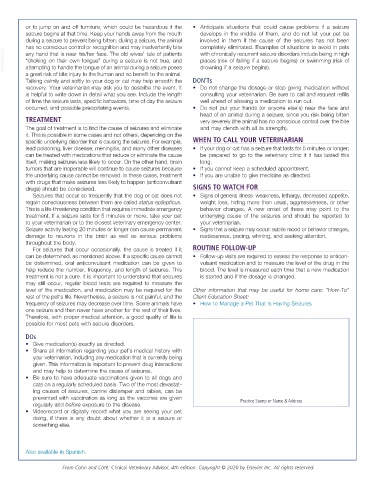Page 3126 - Cote clinical veterinary advisor dogs and cats 4th
P. 3126
or to jump on and off furniture, which could be hazardous if the • Anticipate situations that could cause problems if a seizure
seizure begins at that time. Keep your hands away from the mouth develops in the middle of them, and do not let your pet be
during a seizure to prevent being bitten; during a seizure, the animal involved in them if the cause of the seizures has not been
has no conscious control or recognition and may inadvertently bite completely eliminated. Examples of situations to avoid in pets
VetBooks.ir “choking on their own tongue” during a seizure is not true, and places (risk of falling if a seizure begins) or swimming (risk of
with chronically recurrent seizure disorders include being in high
any hand that is near his/her face. The old wives’ tale of patients
drowning if a seizure begins).
attempting to handle the tongue of an animal during a seizure poses
a great risk of bite injury to the human and no benefit to the animal.
Talking calmly and softly to your dog or cat may help smooth the DON’Ts
recovery. Your veterinarian may ask you to describe the event. It • Do not change the dosage or stop giving medication without
is helpful to write down in detail what you see. Include the length consulting your veterinarian. Be sure to call and request refills
of time the seizure lasts, specific behaviors, time of day the seizure well ahead of allowing a medication to run out.
occurred, and possible precipitating events. • Do not put your hands (or anyone else’s) near the face and
head of an animal during a seizure, since you risk being bitten
TREATMENT very severely (the animal has no conscious control over the bite
The goal of treatment is to find the cause of seizures and eliminate and may clench with all its strength).
it. This is possible in some cases and not others, depending on the
specific underlying disorder that is causing the seizures. For example, WHEN TO CALL YOUR VETERINARIAN
lead poisoning, liver disease, meningitis, and many other diseases • If your dog or cat has a seizure that lasts for 5 minutes or longer;
can be treated with medications that reduce or eliminate the cause be prepared to go to the veterinary clinic if it has lasted this
itself, making seizures less likely to occur. On the other hand, brain long.
tumors that are inoperable will continue to cause seizures because • If you cannot keep a scheduled appointment.
the underlying cause cannot be removed. In these cases, treatment • If you are unable to give medicine as directed.
with drugs that make seizures less likely to happen (anticonvulsant
drugs) should be considered. SIGNS TO WATCH FOR
Seizures that occur so frequently that the dog or cat does not • Signs of general illness: weakness, lethargy, decreased appetite,
regain consciousness between them are called status epilepticus. weight loss, hiding more than usual, aggressiveness, or other
This is a life-threatening condition that requires immediate emergency behavior changes. A new onset of these may point to the
treatment. If a seizure lasts for 5 minutes or more, take your pet underlying cause of the seizures and should be reported to
to your veterinarian or to the closest veterinary emergency center. your veterinarian.
Seizure activity lasting 20 minutes or longer can cause permanent • Signs that a seizure may occur: subtle mood or behavior changes,
damage to neurons in the brain as well as serious problems restlessness, pacing, whining, and seeking attention.
throughout the body.
For seizures that occur occasionally, the cause is treated if it ROUTINE FOLLOW-UP
can be determined, as mentioned above. If a specific cause cannot • Follow-up visits are required to assess the response to anticon-
be determined, oral anticonvulsant medication can be given to vulsant medication and to measure the level of the drug in the
help reduce the number, frequency, and length of seizures. This blood. The level is measured each time that a new medication
treatment is not a cure. It is important to understand that seizures is started and if the dosage is changed.
may still occur, regular blood tests are required to measure the
level of the medication, and medication may be required for the Other information that may be useful for home care: “How-To”
rest of the pet’s life. Nevertheless, a seizure is not painful, and the Client Education Sheet:
frequency of seizures may decrease over time. Some animals have • How to Manage a Pet That Is Having Seizures
one seizure and then never have another for the rest of their lives.
Therefore, with proper medical attention, a good quality of life is
possible for most pets with seizure disorders.
DOs
• Give medication(s) exactly as directed.
• Share all information regarding your pet’s medical history with
your veterinarian, including any medication that is currently being
given. This information is important to prevent drug interactions
and may help to determine the cause of seizures.
• Be sure to have adequate vaccinations given to all dogs and
cats on a regularly scheduled basis. Two of the most devastat-
ing causes of seizures, canine distemper and rabies, can be
prevented with vaccination as long as the vaccines are given
regularly and before exposure to the disease. Practice Stamp or Name & Address
• Videorecord or digitally record what you are seeing your pet
doing, if there is any doubt about whether it is a seizure or
something else.
Also available in Spanish.
From Cohn and Côté: Clinical Veterinary Advisor, 4th edition. Copyright © 2020 by Elsevier Inc. All rights reserved.

